Comparative Root Transcriptome Profiling and Gene Regulatory Network Analysis between Eastern and Western Carrot (Daucus carota L.) Cultivars Reveals Candidate Genes for Vascular Tissue Patterning
Abstract
:1. Introduction
2. Results and Discussion
2.1. Carrot Root Yield Depends on the Secondary Growth
2.2. Reference-Based Assembly and DEGs in Storage Root Transcriptome
2.3. Functional Annotation of DEGs
2.4. Gene Ontology (GO) Terms and KEGG Pathway Annotation of Differentially Expressed Genes
2.4.1. DEGs of Cell Cycle and Cell Wall Metabolism Transcript Profiles
2.4.2. DEGs with Signal Transduction and Related Transcriptome Profiles
2.4.3. DEGs of Starch and Sucrose Metabolism Transcript Profiles
2.5. GRN Associated with VC Patterning between Test Carrot Cultivars
2.6. Expression Validation of DEGs by qPCR
3. Materials and Methods
3.1. Plant Material Preparation for Transcriptome Profiling
3.2. RNA Isolation, Library Preparation, and Sequencing
3.3. Reference Based Assembly & Functional Annotation of Differential Expressed Genes (DEG)
3.4. Gene Regulatory Network (GRN) Analysis with Arabidopsis thaliana Homologs
3.5. Expression Validation of DEGs by qPCR
4. Conclusions
Supplementary Materials
Author Contributions
Funding
Data Availability Statement
Acknowledgments
Conflicts of Interest
References
- Judd, W.S.; Campbell, C.S.; Kellogg, E.A.; Stevens, P.F.; Donoghue, M.J. Plant systematics: A phylogenetic approach. Ecol. Med. 1999, 25, 215. [Google Scholar] [CrossRef]
- Iorizzo, M.; Ellison, S.; Senalik, D.; Zeng, P.; Satapoomin, P.; Huang, J.; Bowman, M.; Iovene, M.; Sanseverino, W.; Cavagnaro, P.; et al. A high-quality carrot genome assembly provides new insights into carotenoid accumulation and asterid genome evolution. Nat. Genet. 2016, 48, 657–666. [Google Scholar] [CrossRef]
- FAO. The State of Food Security and Nutrition in Africa: Building Resilience for Peace and Food Security; FAO: Rome, Italy, 2017. [Google Scholar]
- FAO. 2020. Available online: https://www.fao.org/faostat/#data/QCL/visualize (accessed on 10 September 2023).
- Simon, P.W.; Geoffriau, E.; Ellison, S.; Iorizzo, M. Carrot carotenoid genetics and genomics. In The Carrot Genome; Springer: Cham, Switzerland, 2019; pp. 247–260. [Google Scholar] [CrossRef]
- Heywood, V.H. Relationships and evolution in the Daucus carota complex. Israel J. Plant Sci. 1983, 32, 51–65. [Google Scholar] [CrossRef]
- Spooner, D.M.; Simon, W.; Senalik, D.; Iorizzo, M. Carrot organelle genomes: Organization, diversity, and inheritance. In The Carrot Genome; Springer: Cham, Switzerland, 2019; pp. 205–223. [Google Scholar] [CrossRef]
- Que, F.; Hou, X.L.; Wang, G.L.; Xu, Z.S.; Tan, G.F.; Li, T.; Wang, Y.H.; Khadr, A.; Xiong, A.S. Advances in research on the carrot, an important root vegetable in the Apiaceae family. Hortic. Res. 2019, 6, 1–15. [Google Scholar] [CrossRef]
- Pérez, M.B.; Carvajal, S.; Beretta, V.; Bannoud, F.; Fangio, M.F.; Berli, F.; Fontana, A.; Salomón, M.V.; Gonzalez, R.; Valerga, L.; et al. Characterization of Purple Carrot Germplasm for Antioxidant Capacity and Root Concentration of Anthocyanins, Phenolics, and Carotenoids. Plants 2023, 12, 1796. [Google Scholar] [CrossRef]
- Purkiewicz, A.; Ciborska, J.; Tańska, M.; Narwojsz, A.; Starowicz, M.; Przybyłowicz, K.E.; Sawicki, T. The Impact of the Method Extraction and Different Carrot Variety on the Carotenoid Profile, Total Phenolic Content and Antioxidant Properties of Juices. Plants 2020, 9, 1759. [Google Scholar] [CrossRef]
- Chaitra, K.C.; Sarvamangala, C.; Manikanta, D.S.; Chaitra, P.A.; Fakrudin, B. Insights into genetic diversity and population structure of Indian carrot (Daucus carota L.) accessions. J. Appl. Genet. 2020, 61, 303–312. [Google Scholar] [CrossRef]
- Clotault, J.; Geoffriau, E.; Lionneton, E.; Briard, M.; Peltier, D. Carotenoid biosynthesis genes provide evidence of geographical subdivision and extensive linkage disequilibrium in the carrot. Theor. Appl. Genet. 2010, 121, 659–672. [Google Scholar] [CrossRef]
- Baranski, R.; Maksylewicz-Kaul, A.; Nothnagel, T.; Cavagnaro, F.; Simon, W.; Grzebelus, D. Genetic diversity of carrot (Daucus carota L.) cultivars revealed by analysis of SSR loci. Genet. Resour. Crop Evol. 2012, 59, 163–170. [Google Scholar] [CrossRef]
- Soufflet-Freslon, V.; Jourdan, M.; Clotault, J.; Huet, S.; Briard, M.; Peltier, D.; Geoffriau, E. Functional gene polymorphism to reveal species history: The case of the CRTISO gene in cultivated carrots. PLoS ONE 2013, 8, e70801. [Google Scholar] [CrossRef]
- Maksylewicz, A.; Baranski, R. Intra-population genetic diversity of cultivated carrot (Daucus carota L.) assessed by analysis of microsatellite markers. Acta Biochim. Pol. 2013, 60, 58–63. [Google Scholar] [CrossRef]
- Grzebelus, D.; Iorizzo, M.; Senalik, D.; Ellison, S.; Cavagnaro, P.; Macko-Podgorni, A.; Heller-Uszynska, K.; Kilian, A.; Nothnagel, T.; Allender, C.; et al. Diversity, genetic mapping, and signatures of domestication in the carrot (Daucus carota L.) genome, as revealed by Diversity Arrays Technology (DArT) markers. Mol. Breed. 2014, 33, 625–637. [Google Scholar] [CrossRef] [PubMed]
- Iorizzo, M.; Senalik, D.A.; Ellison, S.L.; Grzebelus, D.; Cavagnaro, F.; Allender, C.; Brunet, J.; Spooner, D.M.; Van Deynze, A.; Simon, W. Genetic structure and domestication of carrot (Daucus carota subsp. sativus) (Apiaceae). Am. J. Bot. 2013, 100, 930–938. [Google Scholar] [CrossRef] [PubMed]
- Ellison, S.L.; Luby, C.H.; Corak, K.E.; Coe, K.M.; Senalik, D.; Iorizzo, M.; Goldman, I.L.; Simon, W.; Dawson, J.C. Carotenoid presence is associated with the or gene in domesticated carrots. Genetics 2018, 210, 1497–1508. [Google Scholar] [CrossRef]
- Ellison, S. Carrot domestication. In The Carrot Genome; Springer: Cham, Switzerland, 2019; pp. 77–91. [Google Scholar] [CrossRef]
- Simon, W.; Freeman, R.E.; Vieira, J.V.; Boiteux, L.S.; Briard, M.; Nothnagel, T.; Michalik, B.; Kwon, Y.S. Carrot. In Handbook of Plant Breeding: Vegetables II: Fabaceae, Liliaceae, Solanaceae, and Umbelliferae; Prohens, J., Nuez, F., Eds.; Springer: New York, NY, USA, 2008; pp. 327–357. [Google Scholar] [CrossRef]
- Machaj, G.; Bostan, H.; Macko-Podgórni, A.; Iorizzo, M.; Grzebelus, D. Comparative transcriptomics of root development in wild and cultivated carrots. Genes 2018, 9, 431. [Google Scholar] [CrossRef]
- Ondrasek, G.; Clode, P.L.; Kilburn, M.R.; Guagliardo, P.; Romić, D.; Rengel, Z. Zinc and Cadmium Mapping in the Apical Shoot and Hypocotyl Tissues of Radish by High-Resolution Secondary Ion Mass Spectrometry (NanoSIMS) after Short-Term Exposure to Metal Contamination. Int. J. Environ. Res. Public Health 2019, 16, 373. [Google Scholar] [CrossRef]
- Ondrasek, G.; Rengel, Z.; Clode, P.L.; Kilburn, M.R.; Guagliardo, P.; Romic, D. Zinc and cadmium mapping by NanoSIMS within the root apex after short-term exposure to metal contamination. Ecotoxicol. Environ. Saf. 2019, 30, 571–578. [Google Scholar] [CrossRef]
- Hoang, N.V.; Choe, G.; Zheng, Y.; Fandiño, A.C.A.; Sung, I.; Hur, J.; Kamran, M.; Park, C.; Kim, H.; Ahn, H.; et al. Identification of conserved gene-regulatory networks that integrate environmental sensing and growth in the root cambium. Curr. Biol. 2020, 30, 2887–2900. [Google Scholar] [CrossRef]
- He, M.; He, C.Q.; Ding, N.Z. Abiotic stresses: General defenses of land plants and chances for engineering multi-stress tolerance. Front. Plant Sci. 2018, 9, 1771. [Google Scholar] [CrossRef]
- Pandey, P.; Irulappan, V.; Bagavathiannan, M.V.; Senthil-Kumar, M. Impact of combined abiotic and biotic stresses on plant growth and avenues for crop improvement by exploiting physio-morphological traits. Front. Plant Sci. 2017, 8, 537. [Google Scholar] [CrossRef]
- Ondrasek, G.; Rengel, Z.; Maurović, N.; Kondres, N.; Filipović, V.; Savić, R.; Blagojević, B.; Tanaskovik, V.; Gergichevich, C.M.; Romić, D. Growth and Element Uptake by Salt-Sensitive Crops under Combined NaCl and Cd Stresses. Plants 2021, 10, 1202. [Google Scholar] [CrossRef]
- Karlova, R.; Boer, D.; Hayes, S.; Testerink, C. Root plasticity under abiotic stress. Plant Physiol. 2021, 187, 1057–1070. [Google Scholar] [CrossRef]
- Huot, B.; Yao, J.; Montgomery, B.L.; He, S.Y. Growth–defense tradeoffs in plants: A balancing act to optimize fitness. Mol. Plant 2014, 7, 1267–1287. [Google Scholar] [CrossRef] [PubMed]
- Kudo, M.; Kidokoro, S.; Yoshida, T.; Mizoi, J.; Kojima, M.; Takebayashi, Y.; Sakakibara, H.; Fernie, A.R.; Shinozaki, K.; Yamaguchi-Shinozaki, K. A gene-stacking approach to overcome the trade-off between drought stress tolerance and growth in Arabidopsis. Plant J. 2019, 97, 240–256. [Google Scholar] [CrossRef] [PubMed]
- Duruflé, H.; Déjean, S. Multi-omics data integration in the context of plant abiotic stress signaling. In Plant Abiotic Stress Signaling; Humana: New York, NY, USA, 2023; pp. 295–318. [Google Scholar] [CrossRef]
- Zachgo, S. Nuclear redox processes in land plant development and stress adaptation. Biol. Chem. 2023, 404, 379–384. [Google Scholar] [CrossRef] [PubMed]
- Zhang, J.; Eswaran, G.; Alonso-Serra, J.; Kucukoglu, M.; Xiang, J.; Yang, W.; Helariutta, Y. Transcriptional regulatory framework for vascular cambium development in Arabidopsis roots. Nat. Plants 2019, 5, 1033–1042. [Google Scholar] [CrossRef] [PubMed]
- Bhandari, S.R.; Rhee, J.; Choi, C.S.; Jo, J.S.; Shin, Y.K.; Song, J.W.; Kim, S.-H.; Lee, J.G. Morphological and Biochemical Variation in Carrot Genetic Resources Grown under Open Field Conditions: The Selection of Functional Genotypes for a Breeding Program. Agronomy 2022, 12, 553. [Google Scholar] [CrossRef]
- Ma, J.; Li, J.; Xu, Z.; Wang, F.; Xiong, A. Transcriptome profiling of genes involving in carotenoid biosynthesis and accumulation between leaf and root of carrot (Daucus carota L.). Acta Biochim. Biophys. Sin. 2018, 50, 481–490. [Google Scholar] [CrossRef]
- Yu, R.; Wang, J.; Xu, L.; Wang, Y.; Wang, R.; Zhu, X.; Sun, X.; Luo, X.; Xie, Y.; Everlyne, M.; et al. Transcriptome Profiling of Taproot Reveals Complex Regulatory Networks during Taproot Thickening in Radish (Raphanus sativus L.). Front. Plant Sci. 2016, 7, 1210. [Google Scholar] [CrossRef] [PubMed]
- Meng, G.; Clausen, S.K.; Rasmussen, S.K. Transcriptome analysis reveals candidate genes related to anthocyanin biosynthesis in different carrot genotypes and tissues. Plants 2020, 9, 344. [Google Scholar] [CrossRef]
- Gohar, T.; Payal, A.; Grant, M.; Anil, K. MAPK machinery in plants: Recognition and response to different stresses through multiple signal transduction pathways. Plant Signal. Behav. 2010, 5, 1372–1380. [Google Scholar] [CrossRef]
- Yao, X.; Feng, H.; Yu, Y.; Dong, A.; Shen, W.H. SDG2-mediated H3K4 methylation is required for proper Arabidopsis root growth and development. PLoS ONE 2013, 8, e56537. [Google Scholar] [CrossRef] [PubMed]
- Banakar, P.; Hada, A.; Papolu, K.; Rao, U. Simultaneous RNAi knockdown of three FMRFamide-like peptide genes, Mi-flp1, Mi-flp12, and Mi-flp18 provides resistance to root-knot nematode, Meloidogyne incognita. Front. Microbiol. 2020, 11, 2690. [Google Scholar] [CrossRef] [PubMed]
- Becerra-Moreno, A.; Redondo-Gil, M.; Benavides, J.; Nair, V.; Cisneros-Zevallos, L.; Jacobo-Velázquez, D.A. Combined effect of water loss and wounding stress on gene activation of metabolic pathways associated with phenolic biosynthesis in carrot. Front. Plant Sci. 2015, 6, 837–841. [Google Scholar] [CrossRef] [PubMed]
- Usuda, H.; Rouhier, H.; Demura, T.; Fukuda, H. Development of sink capacity of the “storage root” in a radish variety with a low ratio of “storage root” to shoot. Plant Cell Physiol. 1999, 40, 1210–1218. [Google Scholar] [CrossRef]
- Pan, J.; Sharif, R.; Xu, X.; Chen, X. Mechanisms of waterlogging tolerance in plants: Research progress and prospects. Front. Plant Sci. 2021, 11, 627331. [Google Scholar] [CrossRef]
- Wang, X.; An, Y.; Xu, P.; Xiao, J. Functioning of PPR proteins in organelle RNA metabolism and chloroplast biogenesis. Front. Plant Sci. 2021, 12, 627501. [Google Scholar] [CrossRef]
- Arias, D.; Maldonado, J.; Silva, H.; Stange, C. A de novo transcriptome analysis revealed that photomorphogenic genes are required for carotenoid synthesis in the dark-grown carrot taproot. Mol. Genet. Genom. 2020, 295, 1379–1392. [Google Scholar] [CrossRef]
- Sung, S.; Amasino, R.M. Vernalization and epigenetics: How plants remember winter. Curr. Opin. Plant Biol. 2004, 7, 4–10. [Google Scholar] [CrossRef] [PubMed]
- Wang, P.; Hsu, C.C.; Du, Y.; Zhu, P.; Zhao, C.; Fu, X.; Zhu, J.K. Mapping proteome-wide targets of protein kinases in plant stress responses. Proc. Natl. Acad. Sci. USA 2020, 117, 3270–3280. [Google Scholar] [CrossRef]
- Wolf, S. Cell wall signaling in plant development and defense. Annu. Rev. Plant Biol. 2022, 73, 323–353. [Google Scholar] [CrossRef] [PubMed]
- Chen, J.T.; Heidari, P. Cell Signaling in Model Plants. Int. J. Mol. Sci. 2020, 21, 6062. [Google Scholar] [CrossRef] [PubMed]
- Rong, J.; Lammers, Y.; Strasburg, J.L.; Schidlo, N.S.; Ariyurek, Y.; De Jong, T.J.; Klinkhamer, G.; Smulders, M.J.; Vrieling, K. New insights into domestication of carrot from root transcriptome analyses. BMC Genom. 2014, 15, 895. [Google Scholar] [CrossRef] [PubMed]
- Cosgrove, D.J. Growth of the plant cell wall. Nat. Rev. Mol. Cell Biol. 2005, 6, 850–861. [Google Scholar] [CrossRef] [PubMed]
- Paque, S.; Mouille, G.; Grandont, L.; Alabadí, D.; Gaertner, C.; Goyallon, A.; Muller, P.; Primard-Brisset, C.; Sormani, R.; Blázquez, M.A.; et al. AUXIN BINDING PROTEIN1 links cell wall remodeling, auxin signaling, and cell expansion in Arabidopsis. Plant Cell 2014, 26, 280–295. [Google Scholar] [CrossRef]
- Guo, M.; Simmons, C.R. Cell number counts--the fw2.2 and CNR genes and implications for controlling plant fruit and organ size. Plant Sci. Int. J. Exp. Plant Biol. 2011, 181, 1–7. [Google Scholar] [CrossRef]
- Treves, H.; Küken, A.; Arrivault, S.; Ishihara, H.; Hoppe, I.; Erban, A.; Höhne, M.; Moraes, T.A.; Kopka, J.; Szymanski, J.; et al. Carbon flux through photosynthesis and central carbon metabolism show distinct patterns between algae, C3 and C4 plants. Nat. Plants 2022, 8, 78–91. [Google Scholar] [CrossRef]
- Yu, R.; Xu, L.; Zhang, W.; Wang, Y.; Luo, X.; Wang, R.; Zhu, X.; Xie, Y.; Karanja, B.; Liu, L. De novo taproot transcriptome sequencing and analysis of major genes involved in sucrose metabolism in radish (Raphanus sativus L.). Front. Plant Sci. 2016, 7, 585–589. [Google Scholar] [CrossRef]
- Xiao, X.; Hu, Y.; Zhang, M.; Si, S.; Zhou, H.; Zhu, W.; Ge, F.; Wu, C.; Fan, S. Transcriptome profiling reveals the genes involved in tuberous root expansion in Pueraria (Pueraria montana var. thomsonii). BMC Plant Biol. 2023, 23, 338. [Google Scholar] [CrossRef]
- Nakano, Y.; Yamaguchi, M.; Endo, H.; Rejab, N.A.; Ohtani, M. NAC-MYB-based transcriptional regulation of secondary cell wall biosynthesis in land plants. Front. plant sci. 2015, 6, 288. [Google Scholar] [CrossRef]
- Wang, X.; Mäkilä, R.; Mähönen, A.P. From procambium patterning to cambium activation and maintenance in the Arabidopsis root. Curr. Opin. Plant Biol. 2023, 75, 102404. [Google Scholar] [CrossRef] [PubMed]
- Chrapačienė, S.; Rasiukevičiūtė, N.; Valiuškaitė, A. Biocontrol of Carrot Disease-Causing Pathogens Using Essential Oils. Plants 2021, 10, 2231. [Google Scholar] [CrossRef] [PubMed]
- Li, M.; Niu, X.; Li, S.; Li, Q.; Fu, S.; Wang, C.; Wu, S. Intercellular signaling across plasmodesmata in vegetable species. Veg. Res. 2023, 3, 22. [Google Scholar] [CrossRef]
- Zhao, L.; Nakazawa, M.; Takase, T.; Manabe, K.; Kobayashi, M.; Seki, M.; Shinozaki, K.; Matsui, M. Overexpression of LSH1, a member of an uncharacterised gene family, causes enhanced light regulation of seedling development. Plant J. 2004, 37, 694–706. [Google Scholar] [CrossRef]
- Xu, K.; Jourquin, J.; Njo, M.F.; Nguyen, L.; Beeckman, T.; Fernandez, A.I. The Phloem Intercalated with Xylem-Correlated 3 Receptor-Like Kinase Constitutively Interacts with Brassinosteroid Insensitive 1-Associated Receptor Kinase 1 and Is Involved in Vascular Development in Arabidopsis. Front. Plant Sci. 2022, 12, 706633. [Google Scholar] [CrossRef]
- Patrick, J.W.; Offler, C.E. Post-sieve element transport of photoassimilates in sink regions. J. Exp. Bot. 1996, 47, 1165–1177. [Google Scholar] [CrossRef]
- Li, S. The Arabidopsis thaliana TCP transcription factors: A broadening horizon beyond development. Plant Signal. Behav. 2015, 10, 1044192. [Google Scholar] [CrossRef]
- Huang, X.; Chen, X.G.; Armbruster, A. Comparative performance of transcriptome assembly methods for non-model organisms. BMC Genom. 2016, 17, 523. [Google Scholar] [CrossRef]
- Hoang, N.V.; Park, C.; Kamran, M.; Lee, J.Y. Gene regulatory network guided investigations and engineering of storage root development in root crops. Front. Plant Sci. 2020, 11, 762. [Google Scholar] [CrossRef]
- Macko-Podgórni, A.; Stelmach, K.; Kwolek, K.; Machaj, G.; Ellison, S.; Senalik, D.A.; Simon, P.W.; Grzebelus, D. Mining for candidate genes controlling secondary growth of the carrot storage root. Int. J. Mol. Sci. 2020, 21, 4263. [Google Scholar] [CrossRef]
- Coenye, T. Do results obtained with RNA-sequencing require independent verification? Biofilm 2021, 3, 100043. [Google Scholar] [CrossRef] [PubMed]
- Stupnikov, A.; McInerney, C.E.; Savage, K.I.; McIntosh, S.A.; Emmert-Streib, F.; Kennedy, R.; Salto-Tellez, M.; Prise, K.M.; McArt, D.G. Robustness of differential gene expression analysis of RNA-seq. Comput. Struct. Biotechnol. J. 2021, 19, 3470–3481. [Google Scholar] [CrossRef] [PubMed]
- Sampathkumar, N.K.; Sundaram, V.K.; Danthi, P.S.; Barakat, R.; Solomon, S.; Mondal, M.; Carre, I.; El Jalkh, T.; Padilla-Ferrer, A.; Grenier, J.; et al. RNA-Seq is not required to determine stable reference genes for qPCR normalization. PLoS Comput. Biol. 2022, 18, 1009868. [Google Scholar] [CrossRef] [PubMed]
- Cholin, S.S.; Poleshi, C.A.; Manikanta, D.S.; Christopher, C. Exploring the genomic resources of carrot for cross-genera transferability and phylogenetic assessment among orphan spices and vegetables of Apiaceae family. Hortic. Environ. Biotechnol. 2019, 60, 81–93. [Google Scholar] [CrossRef]
- Perveen, N.; Cholin, S.S.; Hipparagi, K.; Prabhuling, G.; Murthy, B.N.S.; Peerjade, D. Molecular diversity assessment among the pomegranate genotypes belonging to diverse genetic background using microsatellite markers. Acta Physiol. Plant. 2023, 45, 92. [Google Scholar] [CrossRef]
- Harborne, J.B.; Harborne, J.B. Phenolic compounds. In Phytochemical Methods: A Guide to Modern Techniques of Plant Analysis; Springer: Dordrecht, The Netherlands, 1984; pp. 37–99. [Google Scholar] [CrossRef]
- IPGRI. Descriptors for Wild and Cultivated Carrots (Daucus carota L.); International Plant Genetic Resources Institute: Rome, Italy, 1998. [Google Scholar] [CrossRef]
- Hammer, Ø.; Harper, D.A. Past: Paleontological statistics software package for education and data analysis. Palaeontol. Electron. 2001, 4, 1. [Google Scholar] [CrossRef]
- Bolger, A.M.; Lohse, M.; Usadel, B. Trimmomatic: A flexible trimmer for Illumina sequence data. Bioinformatics 2014, 30, 2114–2120. [Google Scholar] [CrossRef]
- Langmead, B.; Salzberg, S.L. Fast gapped-read alignment with Bowtie 2. Nat. Methods 2012, 9, 357–359. [Google Scholar] [CrossRef]
- Trapnell, C.; Salzberg, S.L. How to map billions of short reads onto genomes. Nat. Biotechnol. 2009, 27, 455–457. [Google Scholar] [CrossRef]
- Trapnell, C.; Williams, B.A.; Pertea, G.; Mortazavi, A.; Kwan, G.; Van Baren, M.J. Tran-script assembly and quantification by RNA-seq reveals unannotated transcripts and isoform switching during cell differentiation. Nat. Biotechnol. 2010, 28, 511–515. [Google Scholar] [CrossRef]
- Benjamini, Y.; Hochberg, Y. Controlling the false discovery rate: A practical and powerful approach to multiple hypothesis testing. J. R. Stat. Soc. B 1995, 57, 289–300. [Google Scholar] [CrossRef]
- Sherman, B.T.; Hao, M.; Qiu, J.; Jiao, X.; Baseler, M.W.; Lane, H.C.; Imamichi, T.; Chang, W. DAVID: A web server for functional enrichment analysis and functional annotation of gene lists (2021 update). Nucleic Acids Res. 2022, 50, W216–W221. [Google Scholar] [CrossRef] [PubMed]
- Ge, S.X.; Jung, D.; Yao, R. ShinyGO: A graphical gene-set enrichment tool for animals and plants. Bioinformatics 2020, 36, 2628–2629. [Google Scholar] [CrossRef] [PubMed]
- Quail, M.A.; Kozarewa, I.; Smith, F.; Scally, A.; Stephens, J.; Durbin, R. A large genome center’s improvement to the Illumina sequencing system. Nat. Methods 2008, 5, 1005–1010. [Google Scholar] [CrossRef]
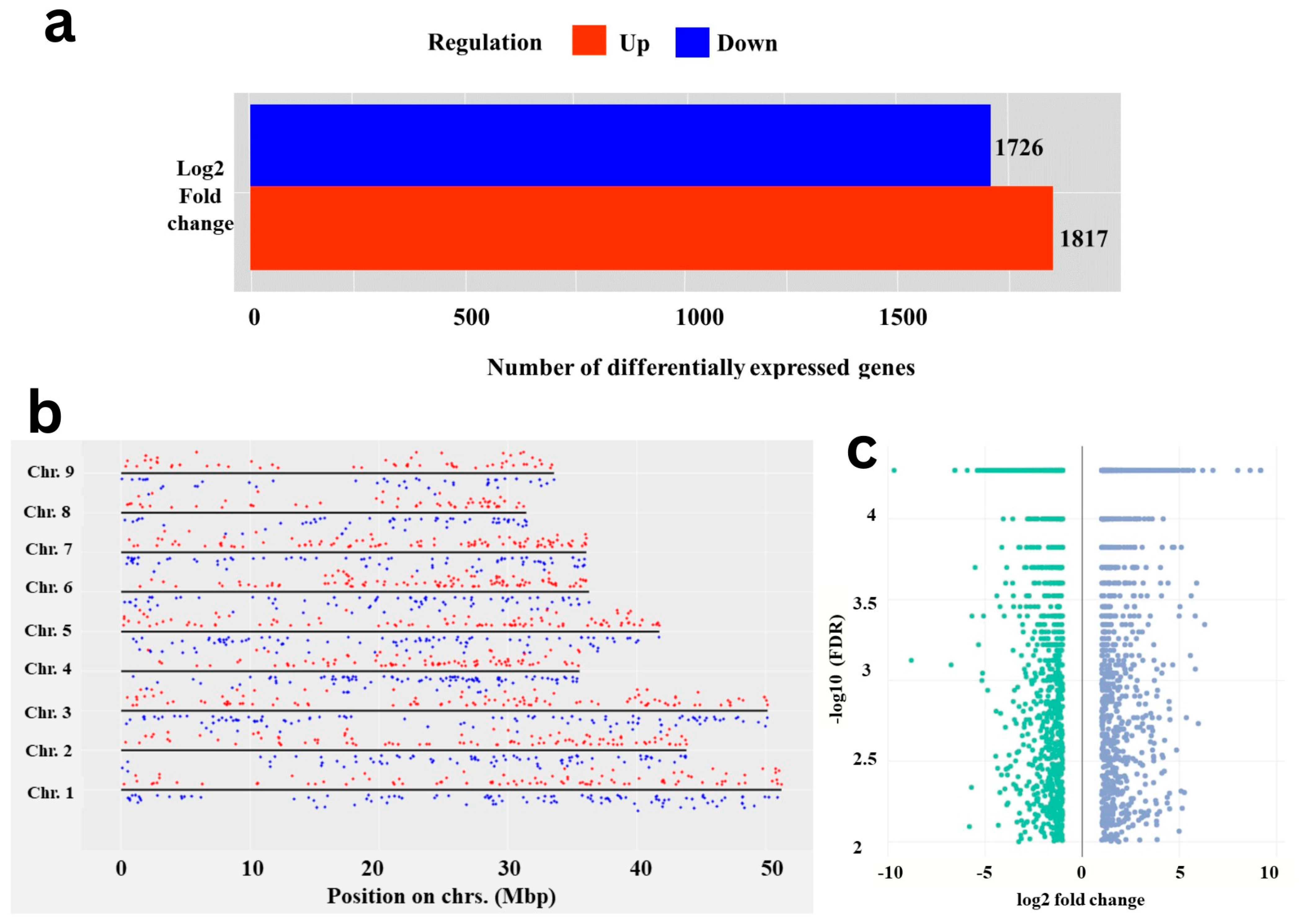

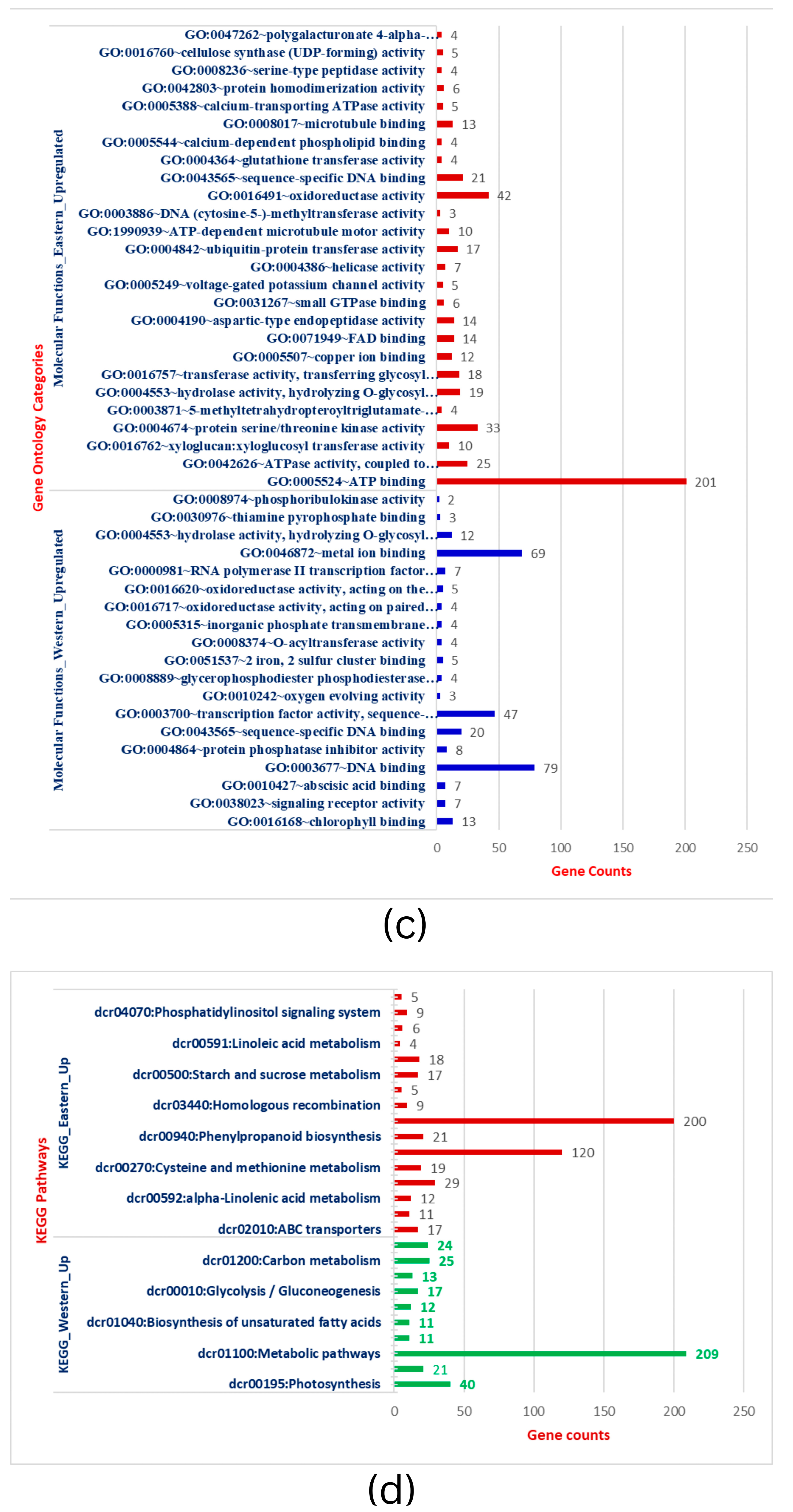
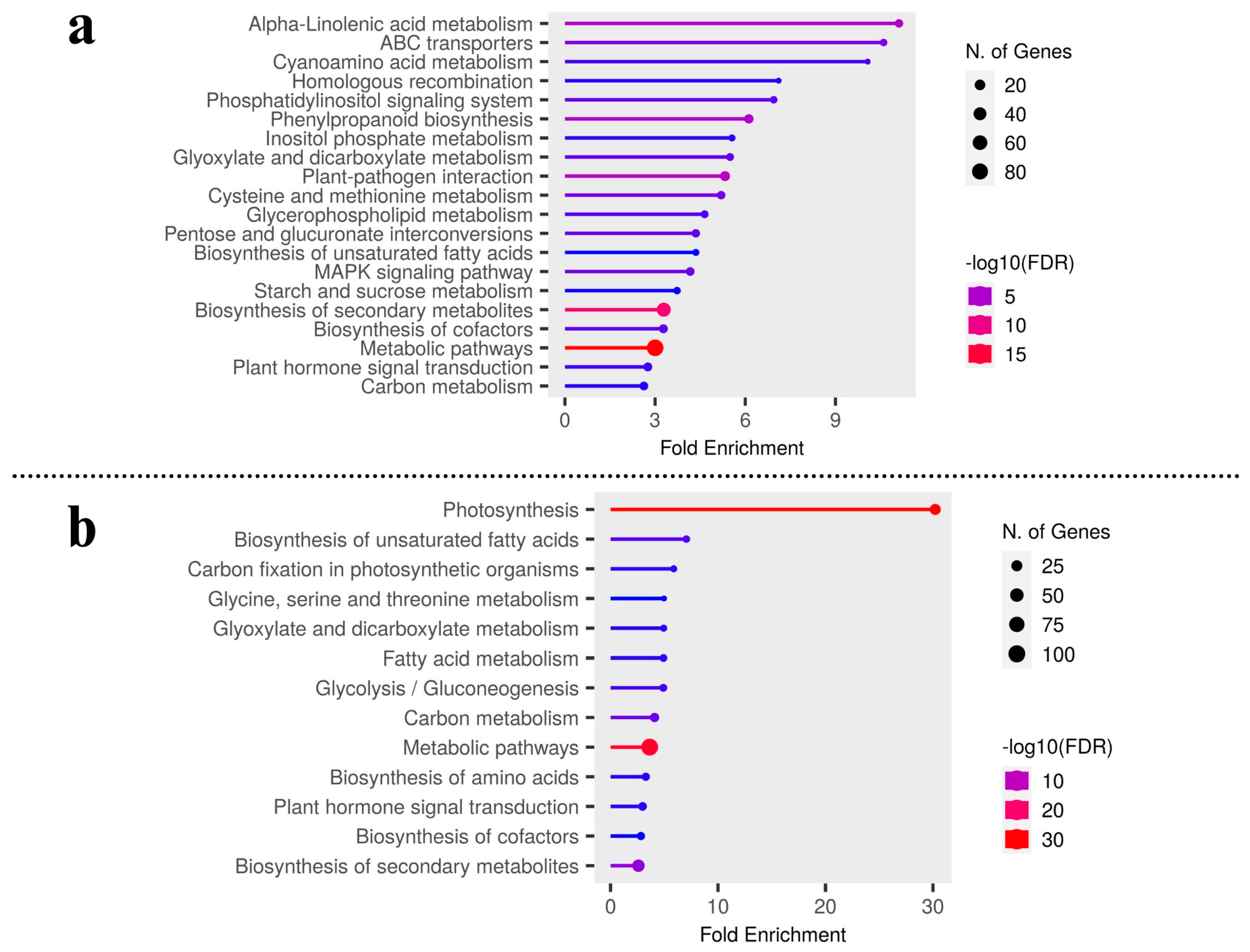
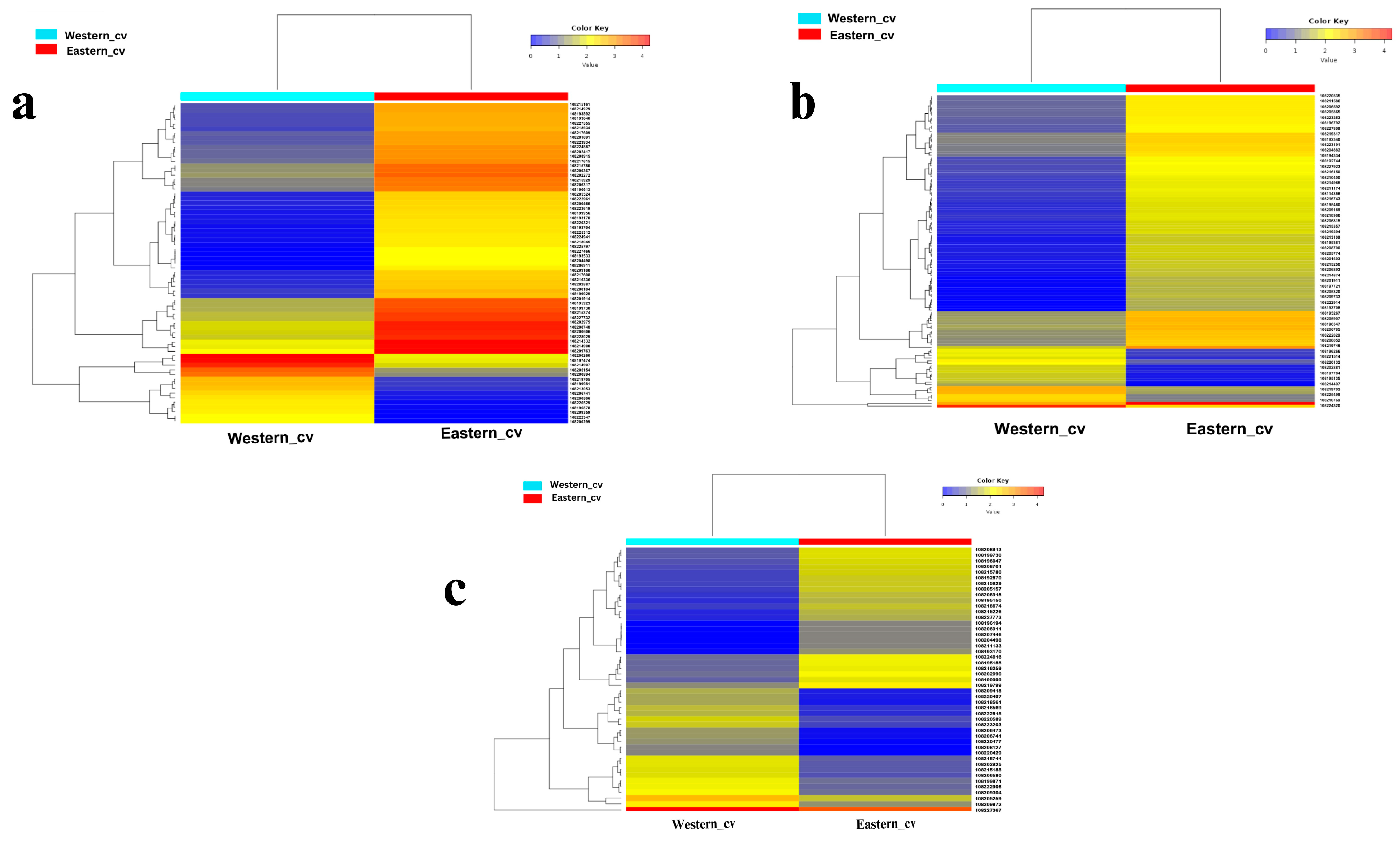
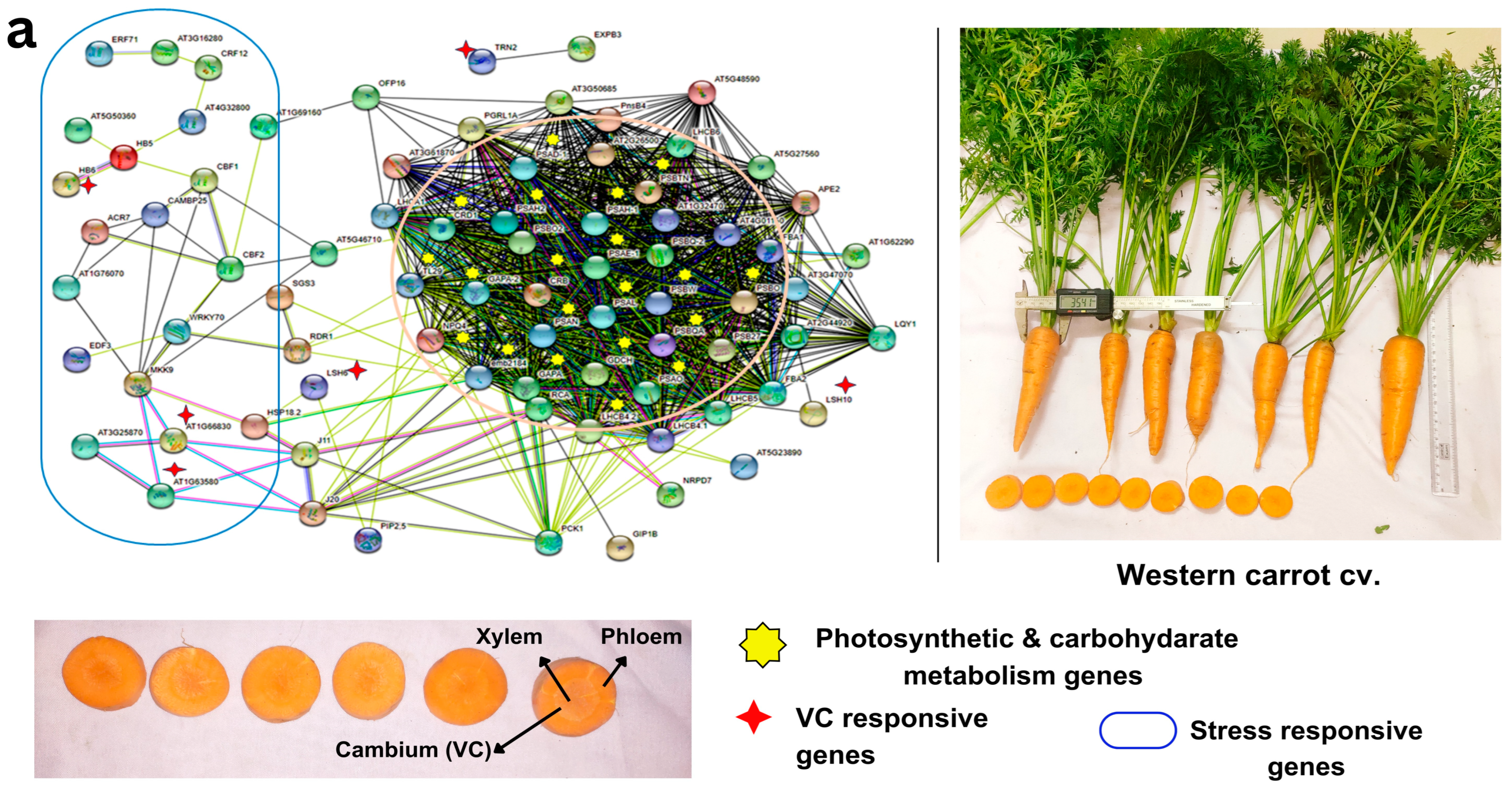
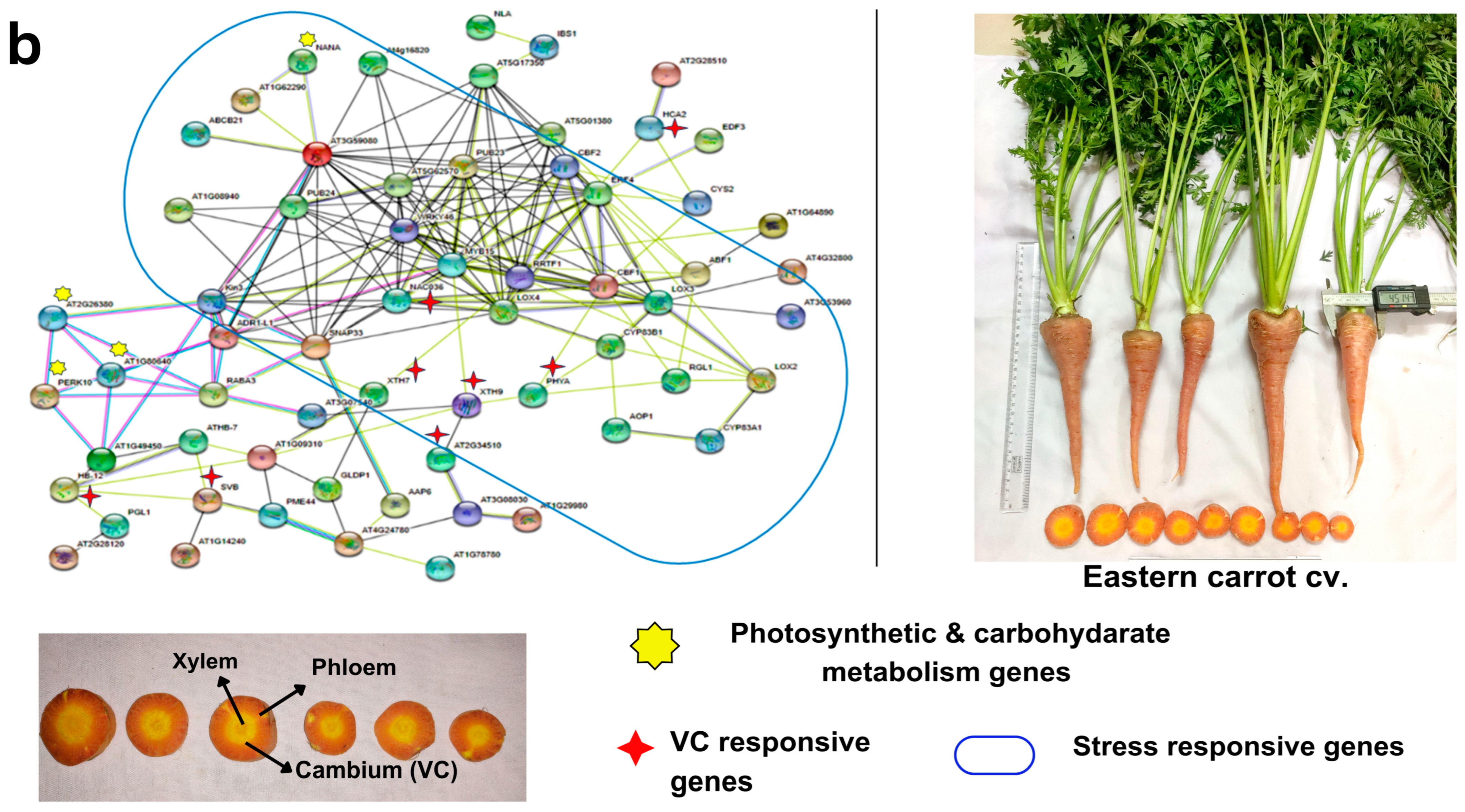
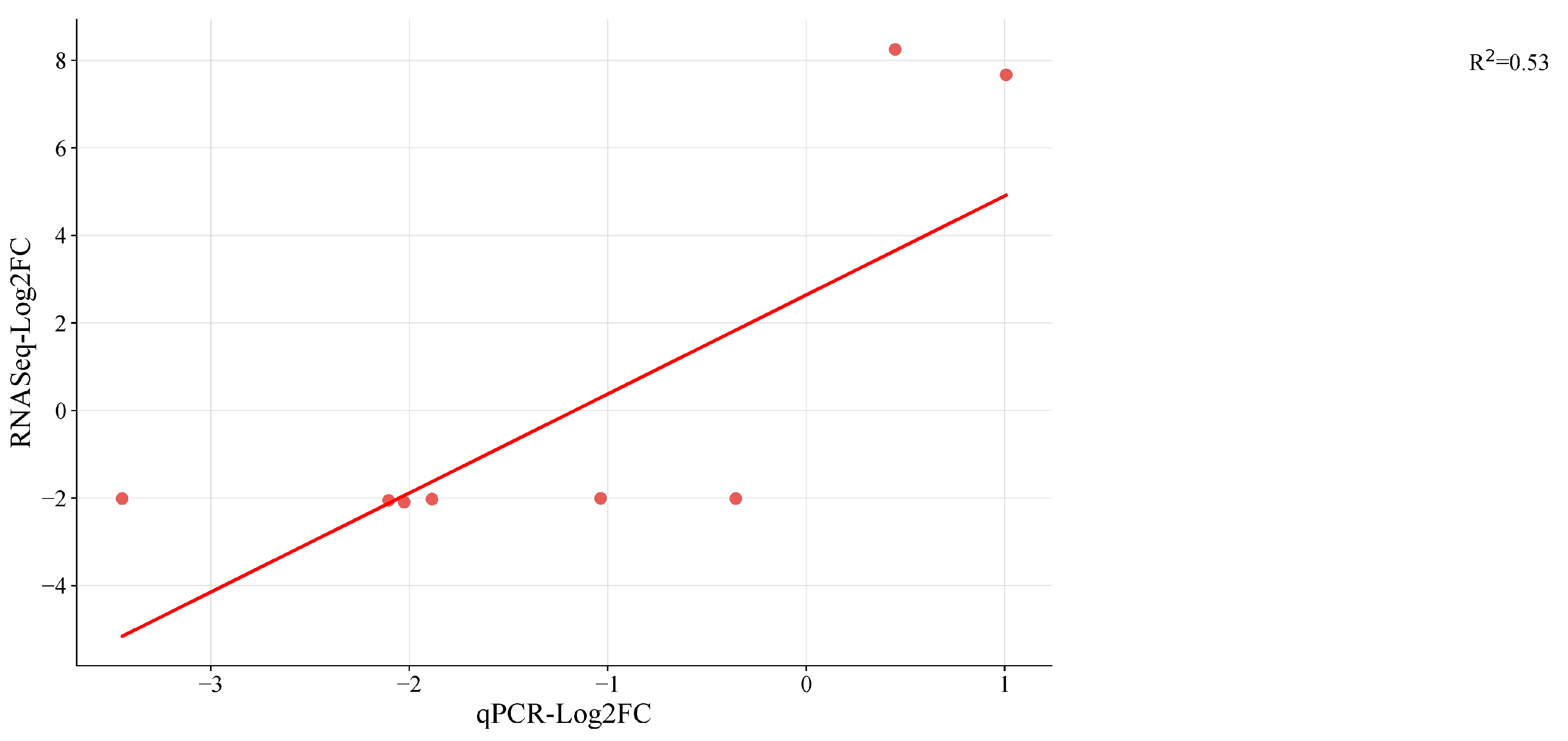
| Traits # | Eastern Cultivar (UHSBC-23-1) | Western Cultivar (UHSBC-100) |
|---|---|---|
| Quantitative parameters * | ||
| Plant height (cm) | 68.13 ± 1.75 a | 53.76 0.73 b |
| Root Length (cm) | 16.52 ± 0.98 a | 13.18 ± 0.26 b |
| Shoot length (cm) | 52.49 ± 1.38 a | 46.64 ± 3.21 b |
| Shoulder Width (cm) | 21.53 ± 1.03 a | 16.22 ± 0.69 b |
| Root diameter (cm) | 26.07 ± 1.61 a | 25.39 ± 0.52 b |
| Phloem width (mm) | 50 ± 0.12 a | 85 ±0.14 b |
| Xylem width (mm) | 82 ± 0.08 a | 40 ± 0.01 b |
| No. of petioles | 7.91 ± 0.25 a | 8.46 ± 0.15 b |
| Shoot weight (g) | 70.91 ± 5.45 a | 24.49 ± 0.96 b |
| Root weight (g) | 72.70 ± 5.88 a | 40.66 ± 4.11 b |
| Plot yield (100 plants) Kg | 6.69 ± 0.62 a | 4.46 ± 0.34 b |
| R/S ratio (Length) | 0.32 ± 0.02 | 0.31 ± 0.01 b |
| R/S ratio (Weight) | 1.39 ± 0.15 | 1.83 ± 0.12 b |
| TSS ° Brix | 7.08 ± 0.11 a | 6.86 ± 0.14 b |
| β-carotene mg/100 mg | 6.5 ± 0.12 b | 8.5 ± 0.16 a |
| Qualitative parameters | ||
| Root Color (External) | Pale Orange/Red | Deep orange |
| Phloem color | Pale orange/Red | Deep orange |
| Xylem/core color | Yellow | Deep orange |
| Root texture | Coarse | Smooth |
| Root shape | Tapering | Cylindrical |
| Leaf type | Normal | Fern |
| Root hairiness | Moderate | Absent |
| Days to maturity | Early (80–85 days) | Late (90–95 DAS) |
| Flowering ability in the tropics | >80% Flowering | Absent |
| Traits | NP | SL | PH | RL | PL | RWD | SWD | VW | XW | PW | RW |
|---|---|---|---|---|---|---|---|---|---|---|---|
| NP | 1 | ||||||||||
| SL | 0.055 | 1 | |||||||||
| PH | 0.282 ** | 0.058 | 1 | ||||||||
| RL | 0.165 * | 0.182 * | 0.273 ** | 1 | |||||||
| PL | 0.15 | −0.039 | 0.527 ** | 0.063 | 1 | ||||||
| RWD | 0.18 | −0.091 | 0.193 * | 0.042 | 0.254 ** | 1 | |||||
| SWD | 0.084 | 0.049 | 0.691 ** | 0.069 | 0.507 ** | 0.558 ** | 1 | ||||
| VW | 0.726 ** | −0.009 | 0.699 ** | 0.135 | 0.312 ** | 0.174 * | 0.481 ** | 1 | |||
| XW | 0.124 | 0.106 | 0.692 ** | 0.097 | 0.432 ** | 0.433 ** | 0.869 ** | 0.440 ** | 1 | ||
| PW | −0.178 | −0.115 | 0.056 | −0.059 | 0.200 * | 0.440 ** | 0.450 ** | −0.166 * | 0.387 ** | 1 | |
| RW | 0.289 ** | 0.096 | 0.637 ** | 0.255 ** | 0.448 ** | 0.675 ** | 0.784 ** | 0.538 ** | 0.726 ** | 0.342 ** | 1 |
| Sample Name | Left-Mapped Reads Rate | Right-Mapped Reads Rate | TopHat Mapping Rate (%) | ||||
|---|---|---|---|---|---|---|---|
| Input Reads | Total Mapped Reads | % Mapped Reads | Input Read | Total Mapped Reads | % Mapped Reads | ||
| Western_R1 | 24,934,401 | 21,882,512 | 87.8 | 24,934,401 | 16,094,457 | 64.5 | 76.2 |
| Western_R2 | 18,142,740 | 13,954,891 | 76.9 | 18,142,740 | 12,009,046 | 66.2 | 71.6 |
| Western_R3 | 21,226,283 | 17,835,932 | 84.0 | 21,226,283 | 17,311,001 | 81.6 | 82.8 |
| Eastern_R1 | 26,766,083 | 22,581,408 | 84.4 | 26,766,083 | 16,356,661 | 61.1 | 72.7 |
| Eastern_R2 | 17,630,817 | 14,595,612 | 82.8 | 17,630,817 | 10,592,745 | 60.1 | 71.4 |
| Eastern_R3 | 21,918,109 | 17,506,456 | 79.9 | 21,918,109 | 12,508,173 | 57.1 | 68.5 |
Disclaimer/Publisher’s Note: The statements, opinions and data contained in all publications are solely those of the individual author(s) and contributor(s) and not of MDPI and/or the editor(s). MDPI and/or the editor(s) disclaim responsibility for any injury to people or property resulting from any ideas, methods, instructions or products referred to in the content. |
© 2023 by the authors. Licensee MDPI, Basel, Switzerland. This article is an open access article distributed under the terms and conditions of the Creative Commons Attribution (CC BY) license (https://creativecommons.org/licenses/by/4.0/).
Share and Cite
Kulkarni, C.C.; Cholin, S.S.; Bajpai, A.K.; Ondrasek, G.; Mesta, R.K.; Rathod, S.; Patil, H.B. Comparative Root Transcriptome Profiling and Gene Regulatory Network Analysis between Eastern and Western Carrot (Daucus carota L.) Cultivars Reveals Candidate Genes for Vascular Tissue Patterning. Plants 2023, 12, 3449. https://doi.org/10.3390/plants12193449
Kulkarni CC, Cholin SS, Bajpai AK, Ondrasek G, Mesta RK, Rathod S, Patil HB. Comparative Root Transcriptome Profiling and Gene Regulatory Network Analysis between Eastern and Western Carrot (Daucus carota L.) Cultivars Reveals Candidate Genes for Vascular Tissue Patterning. Plants. 2023; 12(19):3449. https://doi.org/10.3390/plants12193449
Chicago/Turabian StyleKulkarni, Chaitra C., Sarvamangala S. Cholin, Akhilesh K. Bajpai, Gabrijel Ondrasek, R. K. Mesta, Santosha Rathod, and H. B. Patil. 2023. "Comparative Root Transcriptome Profiling and Gene Regulatory Network Analysis between Eastern and Western Carrot (Daucus carota L.) Cultivars Reveals Candidate Genes for Vascular Tissue Patterning" Plants 12, no. 19: 3449. https://doi.org/10.3390/plants12193449
APA StyleKulkarni, C. C., Cholin, S. S., Bajpai, A. K., Ondrasek, G., Mesta, R. K., Rathod, S., & Patil, H. B. (2023). Comparative Root Transcriptome Profiling and Gene Regulatory Network Analysis between Eastern and Western Carrot (Daucus carota L.) Cultivars Reveals Candidate Genes for Vascular Tissue Patterning. Plants, 12(19), 3449. https://doi.org/10.3390/plants12193449









